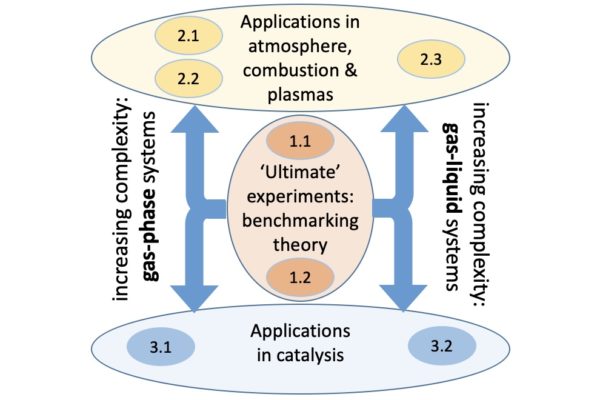About
About
Colliding pairs of molecules in vacuum has become a uniquely powerful method for investigating the fundamental mechanisms through which molecules interact and either exchange energy or chemically react. Scattering experiments of this type have reached a high level of sophistication. Theoretical modelling has progressed in parallel, allowing the forces that act between the molecules to be calculated increasingly accurately and providing rigour to the interpretation of the mechanisms. However, until recently, these advanced methods have only been able to treat small molecular systems, typically containing no more than three atoms and often with only one set of chemical products formed via a single mechanism.
Our vision is to make a dramatic step-change to the field of molecular collisions by extending the range of systems that can be studied to those more typical of real-world applications. Building on a core of fundamental, benchmark studies, we will progress to challenging, previously intractable problems with common features of having multiple reaction pathways and multiple distinct outcomes. This opportunity can only be grasped now because of recent technical advances in experimental methods and conceptual developments in the underlying theory that exploit the exponential growth in available computing power. The Investigators represent a unique team with diverse, complementary experimental and theoretical expertise, drawn from the two centres of excellence for molecular scattering in the UK. We will tackle an ambitious programme under three parallel themes:
- Scattering to benchmark fundamental theory. There is an on-going vital need to continue the advance in scattering experiments towards the goal of controlling fully the quantum states, relative orientation and speed of the incoming molecules, and measuring equally fully the corresponding properties of the products. Such ‘ultimate’ experiments provide the most stringent tests of state-of the-art theoretical predictions. We will perform a series of experiments on collisions of small, highly reactive free radicals (NO, OH) with molecular partners. Complementary advances in theoretical methodology for the calculation of realistic potential energy surfaces, which encode the forces, will allow the observations to be compared against the predictions of advanced-level scattering calculations.
- Scattering for the atmosphere, combustion and plasma science. The chemistry in these environments is driven by highly reactive radicals, ions, or electrons, present at low concentrations but responsible for sequences of reactions that interconvert stable molecules. Some of the most important reactions take place at the interface between the gas phase and liquid or solid surfaces. The major outstanding challenges lie in understanding individual steps in which different products are formed via competing mechanisms. We will answer such questions for several key reaction systems. These include reactions of OH with volatile organic compounds; collisions of electrons with building blocks of DNA, other biomolecules and polycyclic aromatic hydrocarbons (PAHs); and collisions of OH and Cl, important atmospheric oxidants, with the surfaces of liquids representative of aerosol particles.
- Scattering for catalysis. Heterogeneous catalysis is used widely in industry and elsewhere to accelerate the rates of otherwise impractically slow reactions. The underlying mechanisms have in most cases remained unknown, so that optimisation of real-world catalytic processes has been largely through empirical trial-and-error. We will help to overcome this lack of mechanistic insight by investigating reactions on model, mixed transition-metal clusters that mimic the active sites in solid heterogeneous catalysts. We will also develop new scattering methods, based on energetic metal atoms, to characterise the surface structures of ionic liquids, central to their role in forms of multiphase catalysis.

